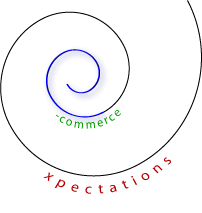In the post-Internet-boom period, it’s easy to forget about some old friends, so here I thought I’d drop in and revisit e-commerce…
 The old joke about commitment being like a ham and eggs breakfast certainly applies to producers (of goods) and consumers in the industrial economy. The punch line is that the chicken (consumer) is involved, but the pig (producer) is committed.
The old joke about commitment being like a ham and eggs breakfast certainly applies to producers (of goods) and consumers in the industrial economy. The punch line is that the chicken (consumer) is involved, but the pig (producer) is committed.
A large part of producers’ inflexibility today is due to the fact that they are committed to bits (as opposed to bytes) at all stages of production and distribution: inputs, inventory, safety stocks, unsold goods, returns “… the whole catastrophe,” as Zorba says. These commitments are, in many cases, more important to producers than putting the customer first, and they represent a critical barrier to industrial economy companies’ intimacy with consumers because companies must sacrifice customer needs to maintain their operating realities. (For more on this, see Transformation: from Self-contained Company to Networked Global Organization.)
E-Commerce is steadily liberating producers from this dilemma in many categories. Let’s take a banal example. Probably most readers have shopped at “Earth’s Biggest Bookstore.” For many people, it defined the e-commerce experience. From the comfort of one’s own desktop came almost limitless variety; in the consulting business myself in the late 90s, it was integrated into my workflow. On engagements, books were mentioned, and they were ordered instantly, delivered next day. There was virtually no possibility that the book was not available. Since those early days, it has only gotten better because used books are integrated into the offering. Virtually no book, CD or DVD is out of print anymore. “Foreign” products are also increasing, although outmoded licensing/distribution agreements put a damper on a truly global market.
Changed Expectations
The point is, once consumers experience predictable sales and self-service on-line, their expectations are fundamentally changed. Suddenly it is intolerable to call the phone company and be transferred to innumerable departments after being on hold for who knows how long to change one’s address or to rectify a billing issue. One thinks, “If they can help me to do these things almost instantly whenever I want, why can’t the others?” This is not intimacy yet, but it empowers the consumer to service him/herself, a very powerful change in the provider/consumer relationship. For one, it is more collaborative. It gets the consumer more involved in the business process; there is no longer a human intermediary in many cases; the consumer interacts directly with the producer’s systems.
Changed Economics
From a product perspective, Chris Anderson’s The Long Tail makes an excellent case for a revolution in product life cycles. He shows the economics of “hits” and campy exceptions. One of his key ideas is that, due to the burden of the distribution of bits products, enterprises could not afford to support or market products that had no chance (based on focus groups and marketing analysis of similar products) of becoming mainstream, huge hits. Anyone in the business will tell you that distribution, returns, shrinkage, breakage and capital costs of bits products are huge. Distributing La Mina to record stores across the U.S. is not worth it because there are not enough Europeans to recognize and buy it. More poignantly, India has very vibrant film and music industries, and there are many Indians in the U.S. However, distribution costs prevent retailers from carrying any of the titles because a store only pulls from a small radius around its location, and the density of Indians is insufficient, save for a few pockets in Silicon Valley. On the Web, however, millions are sold nationwide, profitably, by aggregating demand because shelf space and distribution costs are minimized. The distribution center can be in a rural area where land and labor are cheap. In this scenario, shelf space is infinite; the producer/publisher has infinitely long to make its nut of 100,000. I highly recommend The Long Tail blog while you await the book, which will come out this year. It’s out; see our review.
For many bits products, this fact aligns producers and consumers because it frees producers from the tyranny of retail and distribution costs. Distribution cost is largely variable cost incurred at the time of order, and often paid by the consumer. Of course, the e-commerce model does not work for all products and services; it excels especially with highly standardized products and services. But that includes many products that consumers buy. I expect its portion of total consumer products to increase steadily.
Another instructive example is Dell Computer, which makes products to order and gets paid by customers before it pays its suppliers. Of course, it is not feasible to make everything to order, but many products could be that are not today. Some potential examples: consumer electronics, furniture, cars, and even certain apparel items.
E-Commerce is such a fact of life now that it’s easy to take for granted. However, it’s unleashed profound changes for consumer experience that are rippling through the economy. For one, “retail” is held to a higher standard because technology-enabled service is so much better for many things. The “Long Tail” phenom is a solid indication that ownership cycles and values will be completely changed because, as each generation does more on-line, the secondary market will flourish.

Leave a Reply
You must be logged in to post a comment.